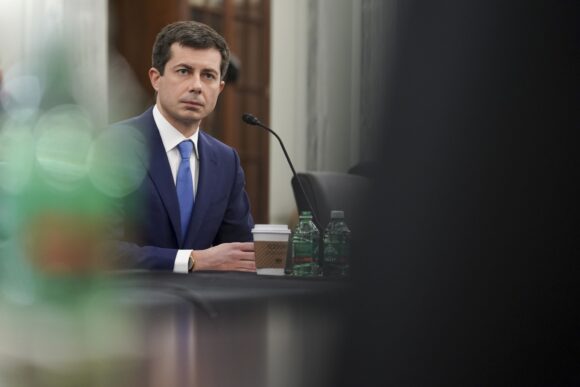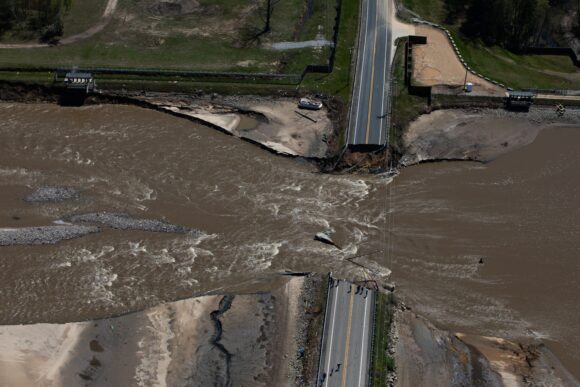Lawmakers in Washington are gearing up for the Biden administration’s first major legislative challenge: a set of measures on long-term economic priorities, including infrastructure and jobs, expected to cost roughly $3 trillion.
Key to President Joe Biden’s Build Back Better plan is the idea that new infrastructure will be ready for climate change—a.k.a. “better” than what we have now. New buildings and roads will have to be designed not just for the present, but also for the future with its rising sea levels and intensifying storms.
Republicans have already expressed skepticism that climate considerations should have any part in the package, including in a committee hearing last week with Transportation Secretary Pete Buttigieg. “The transportation bill, I think, needs to be a transportation bill, not a Green New Deal,” said Rep. Sam Graves of Missouri, summing up the sentiment.

But Republican displeasure is just one hurdle a climate-aware infrastructure bill could face. For lessons on how federally funded infrastructure development actually play outs in the field, the Federal Emergency Management Agency has plenty to offer.
FEMA is accidentally a major funder of infrastructure through its disaster relief programs. In fact, the agency is currently obligated to fund some $123 billion in public-assistance projects. This is separate and above what it spends to replace individual homes through the National Flood Insurance Program.
Building Back Infrastructure
Public assistance grants can pay for cleanup measures such as debris removal, or for protective measures such as levees to keep the next flood from doing so much damage. But the majority of funds go to building back infrastructure like roads and bridges, public utilities, public buildings, and water control facilities.
Just like individual flood insurance payouts, monies for public assistance projects have ballooned in recent years as climate change has increased the number and severity of natural disasters, from wildfires to hurricanes. In the last five years alone, the funds obligated in this category have nearly doubled, from about $62 billion in 2016.
And also just like at the individual home level, the public assistance program has run up against local desires to rebuild infrastructure as similar as possible to what it was before, rather than a better version that will survive in a climate-altered future. In the U.S., localities have a great deal of say in the placing and prioritizing of infrastructure.
Gavin Smith, a professor of environmental planning at North Carolina State University College of Design, is also a frequent advisor to his state government on disaster recovery. He said the challenges on the local end are both numerous and sizable. For starters, local planning departments frequently don’t have experience in long-term risk assessment. It takes expertise to answer the question, “Does that local school just need hurricane shutters, or does it need to be moved entirely?,” he said.
Then there’s the problem of space. Building to avoid the floods of the future can require the use of additional land that towns don’t yet own—or want to give over to infrastructure, if they do.
Finally, there’s the question of patience. To build back better not only takes more money, it takes more planning, and therefore more time. “It is speed versus deliberation,” said Smith. “To build better infrastructure requires political will, and by that I mean local officials need to say what is good for the long run, not just my election cycle.”
Joel Scata, a water and climate attorney with the Natural Resources Defense Council, agrees that these are all formidable challenges. Like Smith, he thinks some of these can be mitigated by allowing some federal funds to be used by municipalities to build up their planning capacity and technical know-how. This is especially important for the already underfunded low-income and historically marginalized communities Biden wants to target with help. “Having local expertise for these projects is going to be imperative,” he said.
Top Photo: A road collapsed due to flood water is seen in this aerial photograph taken after dams failed in Midland, Michigan, U.S., on Wednesday, May 20, 2020. President Donald Trump said he’s sending federal emergency workers to Midland, Michigan, where dam failures have flooded a Dow Inc. chemical complex and homes in a disaster that may force the evacuation of more than 10,000 people. Photographer: Emily Elconin/Bloomberg
Topics FEMA
Was this article valuable?
Here are more articles you may enjoy.



 Trump to Issue Order Creating National AI Rule
Trump to Issue Order Creating National AI Rule  Viewpoint: Agentic AI Is Coming to Insurance Industry – Much Faster Than You Think
Viewpoint: Agentic AI Is Coming to Insurance Industry – Much Faster Than You Think  Chubb, The Hartford, Liberty and Travelers Team Up on Surety Tech Launch
Chubb, The Hartford, Liberty and Travelers Team Up on Surety Tech Launch  WTW to Acquire Newfront in Deal Worth Up to $1.3B
WTW to Acquire Newfront in Deal Worth Up to $1.3B 

